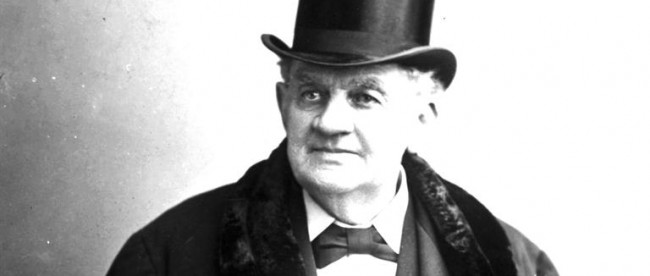P.T. Barnum’s Final Attraction

In 1875, two men from Wisconsin convinced P.T. Barnum, the famed showman, to join their business — a circus. Barnum’s job was to lend his name to the product and,ultimately, his wisdom as well, and the circus became known as “P.T. Barnum’s Great Traveling Museum, Menagerie, Caravan, and Hippodrome.” Barnum would later partner with James Anthony Bailey, the ringmaster of another circus, and the combined show would thereafter be known as the Barnum and Bailey Circus — “the Greatest Show on Earth.” Despite the fact that Barnum was in his mid-60s before he entered the circus game, that’s probably what he’s best known for.
But — as the original name of his circus suggests — that wasn’t his original claim to fame. In 1841, Barnum purchased a museum in downtown Manhattan and turned it into a collection of oddities, mysteries, and other exhibits that piqued the curiosity of visitors from near and far. Barnum’s American Museum, as it was called, proved incredibly popular.
A little too popular, in fact. Barnum had more guests than he could reasonable accommodate. So he came up with a solution: an exhibit that few visitors could resist — until it was too late.
According to Wikipedia, Barnum’s museum hosted 38 million visitors from its opening in 1841 until it burned down in 1865 — a huge number, given that the population of the United States at the time was only about 32 million. Wikipedia further notes that at its peak, the museum saw 15,000 visitors a day, which was roughly the number of people that the Metropolitan Museum of Art boasted about hosting on an average day in 2011. Tickets cost a quarter — about $5 to $10 in today’s dollars — and you could wander the museum for as long as you wanted for that price. Unfortunately for Barnum, many visitors did just that, and after a while, the museum got so crowded that no one else could be admitted. So Barnum introduced a new attraction: the egress.
To alert visitors to the egress, Barnum simply put up some signs. In various places in the museum, visitors would be directed toward the new attraction by mysterious signs which simply read “This Way to the Egress” (or, per some sources, “This Way to the Great Egress”) without further explanation. Wanting to see what this egress thing was — a bird, perhaps? — visitors who were previously slow to flow through the museum began fleetly moving their way past one exhibit and onto the next. Ultimately, they’d meet the door marked “egress” and make their way though, expecting a surprise.
And a surprise is exactly what they got. P.T. Barnum is famous for saying “there’s a sucker born every minute” (even if he never did), and those who most desperately wished to see the egress were probably his best example. The word “egress” means “exit.” The visitor who had found the egress had left the museum, and to re-enter, had to pony up another twenty-five cents.
 Bonus Fact: In 1965, the United States Supreme Court decided the case of Griswold v. Connecticut, a suit over whether Connecticut’s law criminalizing contraception was constitutional. The Court found that the law was unconstitutional, basing their ruling on an implied right to privacy in the founding document. That right to privacy has been cited in many different landmark Court cases since. And it may not have happened if it weren’t for P.T. Barnum, at least not in that way. Barnum, nearly 100 years earlier, served in the Connecticut legislature and was a co-sponsor of the anti-contraception law.
Bonus Fact: In 1965, the United States Supreme Court decided the case of Griswold v. Connecticut, a suit over whether Connecticut’s law criminalizing contraception was constitutional. The Court found that the law was unconstitutional, basing their ruling on an implied right to privacy in the founding document. That right to privacy has been cited in many different landmark Court cases since. And it may not have happened if it weren’t for P.T. Barnum, at least not in that way. Barnum, nearly 100 years earlier, served in the Connecticut legislature and was a co-sponsor of the anti-contraception law.
From the Archives: Beware the Unicycling Clown: It has nothing to do with circuses.
Take the Quiz: Nabisco has made Barnum’s Animal Crackers since 1902. Name the four animals which have always been part of the collection. (Extra fact: Nabisco doesn’t pay Barnum & Bailey for the use of the Barnum name — and never licensed the name from P.T. Barnum, either, according to the Los Angeles Times.)
Related: “The Art of Money Getting; Or, Golden Rules for Making Money” by P.T. Barnum. 4.3 stars on 121 reviews. About 68 pages if printed.
